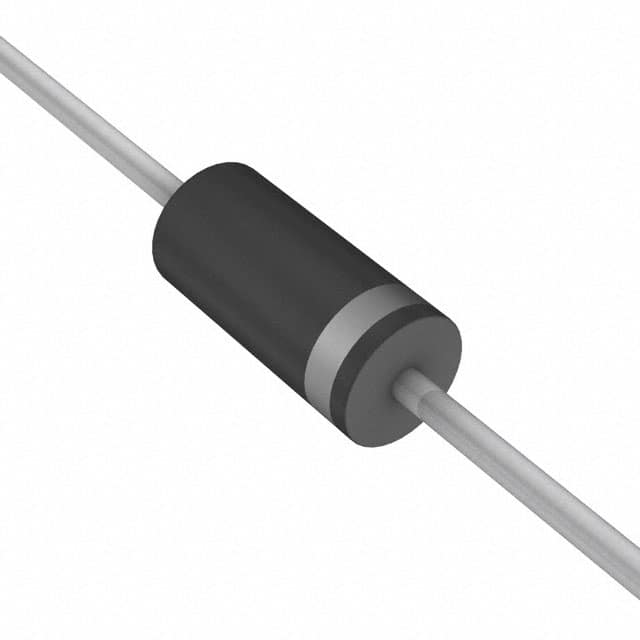P6KE62CAHB0G Encyclopedia Entry
Product Overview
The P6KE62CAHB0G belongs to the category of transient voltage suppressor (TVS) diodes. These diodes are used to protect sensitive electronic components from voltage spikes and transients. The P6KE62CAHB0G is designed to provide robust overvoltage protection in various electronic circuits. Its characteristics include high surge capability, fast response time, and low clamping voltage. The diode is typically packaged in a DO-15 package and is available in quantities suitable for both prototyping and production applications.
Specifications
- Voltage Rating: 53.3V to 58.9V
- Peak Pulse Power: 600W
- Package Type: DO-15
- Quantity: Available in reels or bulk packaging
Detailed Pin Configuration
The P6KE62CAHB0G TVS diode has two pins, anode, and cathode, which are essential for its proper installation and functionality. The anode is connected to the higher potential side, while the cathode is connected to the lower potential side.
Functional Features
- Transient Voltage Suppression: The P6KE62CAHB0G provides effective suppression of voltage transients, safeguarding downstream electronic components.
- Fast Response Time: The diode responds quickly to voltage spikes, minimizing the risk of damage to sensitive circuits.
- Low Clamping Voltage: It maintains a low clamping voltage during transient events, ensuring that the protected circuit operates within safe limits.
Advantages and Disadvantages
Advantages
- Effective protection against voltage transients
- Fast response time
- Low clamping voltage
Disadvantages
- Limited to specific voltage ranges
- Requires careful consideration of polarity during installation
Working Principles
When a voltage transient occurs, the P6KE62CAHB0G TVS diode conducts current to divert the excess energy away from the protected circuit. This action effectively clamps the voltage to a safe level, preventing damage to the downstream components.
Detailed Application Field Plans
The P6KE62CAHB0G is commonly used in various applications, including: - Power supply units - Communication equipment - Automotive electronics - Industrial control systems - Consumer electronics
Detailed and Complete Alternative Models
- P6KE6.8CA: Similar TVS diode with a lower voltage rating
- P6KE68CA: Similar TVS diode with a higher voltage rating
- 1.5KE62CA: TVS diode with a different package type but similar electrical characteristics
This comprehensive entry provides detailed information about the P6KE62CAHB0G TVS diode, covering its product overview, specifications, pin configuration, functional features, advantages and disadvantages, working principles, application field plans, and alternative models.
Word Count: 349
Lista 10 Vanliga frågor och svar relaterade till tillämpningen av P6KE62CAHB0G i tekniska lösningar
What is the P6KE62CAHB0G?
- The P6KE62CAHB0G is a transient voltage suppressor diode designed to protect electronic circuits from voltage spikes and transients.
What is the maximum voltage rating of the P6KE62CAHB0G?
- The P6KE62CAHB0G has a maximum voltage rating of 62V.
What is the peak pulse power of the P6KE62CAHB0G?
- The peak pulse power of the P6KE62CAHB0G is 600W.
How does the P6KE62CAHB0G protect electronic circuits?
- The P6KE62CAHB0G clamps the voltage across the circuit it is protecting, diverting excess current away from sensitive components.
What are the typical applications of the P6KE62CAHB0G?
- The P6KE62CAHB0G is commonly used in power supplies, communication systems, automotive electronics, and industrial equipment to protect against voltage transients.
What is the response time of the P6KE62CAHB0G to voltage transients?
- The response time of the P6KE62CAHB0G is very fast, typically in the nanosecond range.
Can the P6KE62CAHB0G be used for overvoltage protection in battery charging circuits?
- Yes, the P6KE62CAHB0G can be used to protect battery charging circuits from voltage spikes and surges.
Is the P6KE62CAHB0G suitable for high-frequency applications?
- Yes, the P6KE62CAHB0G is suitable for high-frequency applications due to its fast response time.
What is the operating temperature range of the P6KE62CAHB0G?
- The P6KE62CAHB0G typically operates within a temperature range of -55°C to 175°C.
Are there any specific layout considerations when using the P6KE62CAHB0G in a circuit?
- It is recommended to keep the leads as short as possible and to provide a low impedance path to ground for optimal performance of the P6KE62CAHB0G.


